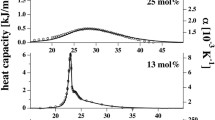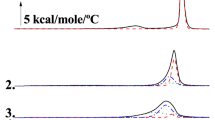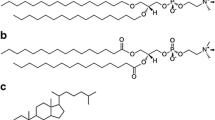Abstract
Lipid bilayers and monolayers composed of dimyristoylphosphatidic acid (DMPA) and cholesterol were characterized by differential scanning calorimetry and film balance measurements. Increasing cholesterol content decreases the bilayer phase transition temperature and enthalpy in a manner similar to that observed before for other lipid/cholesterol systems. In monomolecular films at the air-water interface cholesterol exhibits the well known condensing effect in the liquid-expanded phase, while the liquid-condensed phase is less affected. As with the bilayer phase transition, the transition temperature and change in area at the liquid-condensed to liquid-expanded phase transition, as measured from isobars at 25 dynes/cm, decreases with increasing cholesterol content. The kinetics of the phase transition of DMPA/cholesterol bilayers were measured using the pressure jump relaxation technique with optical detection. Three relaxation times were observed. The relaxation times and amplitudes pass through maximum values at the transition midpoint. With increasing cholesterol content the maximum values of the relaxation times decrease but not in a linear fashion. The time constants display an intermediate maximum at ca. 10% to 12 mol% cholesterol. This observation is discussed in terms of a possible change in the nature of the phase transition from first-order with phase separation to a continuous second-order transition. The dependence of the relaxation amplitudes on cholesterol content gave evidence for nucleation being the rate limiting step for the transition in this particular system.
Similar content being viewed by others
Abbreviations
- DMPA :
-
dimyristoylphosphatidic acid
- DMPC :
-
dimyristoylphosphatidylcholine
- DMPE :
-
dimyristoylphosphatidylethanolamine
- DPPC :
-
dipalmitoylphosphatidylcholine
- DSC :
-
differential scanning calorimetry
References
Adam G (1968) Ionenstrom nach einem depolarisierenden Sprung im Membranpotential. Z Naturforschg 236:181–197
Albrecht O, Gruler H, Sackmann E (1978) Polymorphism of phospholipid monolayers. J Phys (Paris) 39:301–313
Albrecht O, Gruler H, Sackmann E (1981) Pressure-composition phase diagrams of cholesterol/lecithin, cholesterol/phosphatidic acid, and lecithin/phosphatidic acid mixed monolayers. A Langmuir film balance study. J. Colloid Interface Sci 79:319–338
Blume A (1979) A comparative study of the phase transition of phospholipid bilayers and monolayers. Biochim Biophys Acta 557:32–44
Blume A (1980) Thermotropic behavior of phosphatidylethanolamine-cholesterol and phosphatidylethanolamine-phosphatidylcholine-cholesterol mixtures. Biochemistry 19:4908–4913
Blume A (1983) Apparent molar heat capacities of phospholipids in aqueous dispersion. Effects of chain length and head group structure. Biochemistry 22:5436–5442
Blume A, Griffin RG (1982) Carbon-13 and deuterium nuclear magnetic resonance study of the interaction of cholesterol with phosphatidylethanolamine. Biochemistry 21:6230–6242
Blume A, Wittebort RJ, Das Gupta SK, Griffin RG (1982) Phase equilibria, molecular conformation and dynamics in phosphatidylcholine/phosphatidylethanolamine bilayers. Biochemistry 21:6243–6253
Calhoun, WI, Shipley GG (1979) Sphingomyelin-lecithin bilayers and their interaction with cholesterol. Biochemistry 18:1717–1722
Chapman D, Wallach DFH (1968) Recent physical studies of phospholipids and natural membranes. In: Chapman D (ed) Biological membranes. Academic Press, London New York, pp 125–202
Demel RA, de Kruijff B (1976) The function of sterols in membranes. Biochim Biophys Acta 457:109–132
Eck V, Holzwarth JF (1984) Fast dynamic phenomena in vesicles of phospholipids during the phase transition. In: Mittal KL, Lindman B (eds) Surfactants in solution. Plenum Press, New York, pp 2059–2079
Elamrani K, Blume A (1983) Phase transition kinetics of phosphatidic acid bilayers. A pressure jump relaxation study. Biochemistry 22:3305–3311
Elamrani K, Blume A (1984) Phase transition kinetics of phosphatidic acid bilayers. A stopped-flow-study of the electrostatically induced transition. Biochim Biophys Acta 769: 578–584
Estep TN, Mountcastle DB, Biltonen RL, Thompson TE (1978) Studies on the anomalous thermotropic behavior of aqueous dispersions of dipalmitoylphosphatidylcholine-cholesterol mixtures. Biochemistry 17:1984–1987
Estep TN, Mountcastle DB, Barenholz Y, Biltonen RL, Thompson TE (1979) Thermal behavior of synthetic sphingomyelin-cholesterol dispersions. Biochemistry 18: 2112–2117
Georgallas A, Hunter DL, Lookman T, Zuckermann MJ, Pink DA (1984) Interaction between two sheets of a bilayer membrane and its internal lateral pressure. Eur Biophys J 11:79–86
Gruenewald B, Blume A, Watanabe F (1980) Kinetic investigations on the phase transition of phospholipid bilayers. Biochim Biophys Acta 597:41–52
Gruenewald B, Frisch W, Holzwarth JF (1981) The kinetics of the formation of rotational isomers in the hydrophobic tail region of phospholipid bilayers. Biochim Biophys Acta 641:311–319
Hui SW (1981) Geometry of phase-separated domains in phospholipid bilayers by diffraction contrast electron microscopy. Biophys J 34:383–395
Hui SW, He NB (1983) Molecular organization in cholesterollecithin bilayers by X-ray and electron diffraction measurements. Biochemistry 22:1159–1164
Jähnig F (1981 a) Critical effects from lipid-protein interactions in membranes I. Theoretical description. Biophys J 36:329–343
Jähnig F (1981 b) Critical effects from lipid-protein interactions II. Interpretation of experimental results. Biophys J 36:344–357
Jähnig F, Harlos K, Vogel H, Eibl H (1979) Electrostatic interactions at charged lipid membranes. Electrostatically induced tilt. Biochemistry 18:1459–1468
Kanehisa MI, Tsong TY (1978) Cluster model of lipid phase transitions with application to passive permeation of molecules and structure relaxations in lipid bilayers. J Am Chem Soc 100:424–432
Knoche W, Wiese G (1976) Pressure jump relaxation with optical detection. Rev Sci Instrum 47:220–221
Ladbrooke BD, Williams RM, Chapman D (1968) Studies on lecithin-cholesterol-water interactions by differential scanning calorimetry and X-ray diffraction. Biochim Biophys Acta 150:333–343
Lentz BR, Barrow DA, Hoechli M (1980) Cholesterol-phosphatidylcholine interactions in multilamellar vesicles. Biochemistry 19:1943–1954
Mabrey S, Mateo PL, Sturtevant JM (1978) High-sensitivity scanning calorimetry study of mixtures of cholesterol with dimyristoyl- and dipalmitoylphosphatidylcholines. Biochemitry 17:2464–2468
Marcelja S (1974) Chain ordering in liquid crystals II. Structure of bilayer membranes. Biochim Biophys Acta 367: 265–276
McIntosh TJ (1980) Differences in hydrocarbon chain tilt between hydrated phosphatidylethanolamine and phosphatidylcholine bilayers. A molecular packing model. Biophys J 29:237–246
Mitaku S, Jippo T, Kataoka R (1983) Thermodynamic properties of the lipid bilayer transition. Pseudocritical phenomena. Biophys J 42:137–144
Mouritsen OG (1983) Studies on the lack of cooperativity in the melting of lipid bilayers. Biochim Biophys Acta 731: 217–221
Mouritsen OG, Zuckermann MJ (1985) Softening of lipid bilayers. Eur Biophys J 12:75–86
Mouritsen OG, Boothroyd A, Harris R, Jan N, Lookman T, MacDonald L, Pink DA, Zuckermann MJ (1983) Computer simulation of the main gel — fluid phase transition of lipid bilayers. J Chem Phys 79:2027–2041
Müller-Landau F, Cadenhead DA (1979) Molecular packing in steroid-lecithin monolayers. Part II. Mixed films of cholesterol with dipalmitoylphosphatidylcholine and tetradecanoic acid. Chem Phys Lipids 25:315–328
Nagle JF (1976) Theory of lipid monolayer and bilayer phase transitions: Effect of headgroup interactions. J Membr Biol 27:233–250
Pink DA, Chapman D (1979) Protein-lipid interactions in bilayer membranes: A lattice model. Proc Natl Acad Sci USA 76:1542–1546
Rubinstein JLR, Smith BA, McConnell HM (1979) Lateral diffusion in binary mixtures of cholesterol and phosphatidylcholines. Proc Natl Acad Sci USA 76:15–18
Snyder B, Freire E (1980) Compositional domain structure in phosphatidylcholine-cholesterol and sphingomyelin-cholesterol bilayers. Proc. Natl Acad Sci USA 77:4055–4059
Wittebort RJ, Blume A, Huang TH, Das Gupta SK, Griffin RG (1982) Carbon-13 nuclear magnetic resonance investigations of phase transitions and phase equilibria in pure and mixed phospholipid bilayers. Biochemistry 21: 3487–3502
Author information
Authors and Affiliations
Rights and permissions
About this article
Cite this article
Blume, A., Hillmann, M. Dimyristoylphosphatidic acid/cholesterol bilayers. Eur Biophys J 13, 343–353 (1986). https://doi.org/10.1007/BF00265670
Received:
Accepted:
Issue Date:
DOI: https://doi.org/10.1007/BF00265670




